Programmed and Projected by Julian Antos, Becca Hall, Rebecca Lyon, Kyle Westphal, and Cameron Worden.
Additional capsules by Julia Reinitz. Volunteer: Jiayi Chen
Our screenings are held at multiple venues around Chicago, including:
- The Auditorium at Northeastern Illinois University (Building E) – 3701 W. Bryn Mawr Ave., Chicago, IL 60625
Tickets: General Admission: $7 • NEIU Students: $2
- The Music Box Theatre – 3733 N. Southport Ave., Chicago, IL 60613
Tickets: $7 – $11
- Film Studies Center at The Logan Center for the Arts – 915 E. 60th St., Chicago, IL 60637
Free Admission
Saturday, January 6 @ Noon / Music Box Theatre / Live Accompaniment from Music Box Organist Dennis Scott
BEHIND THE DOOR
Directed by Irvin V. Willat • 1919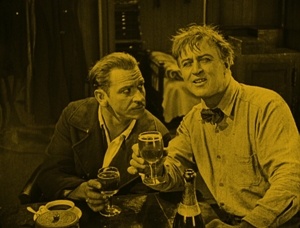
Spun out from a two-page short story by Gouverneur Morris, Behind the Door is one of the most perverse and unpredictable films of the silent era—a nautical revenge yarn that alternates appalling sadism with prayerful longing for days gone by. (Morris’s novel The Penalty would be adapted into an excellent Lon Chaney film the following year, and that pulp saga of a gangster amputee plays almost level-headed in comparison.) Hobart Bosworth stars as Captain Oscar Krug, a lumbering taxidermist whose quiet life off the coast of Maine is interrupted by America’s entry into World War I. As an American of German descent, Krug must prove his patriotic bona fides by enlisting, but even he underestimates the depravity of the enemy (a slick and smarmy Wallace Beery) and the destructive power of the U-Boat. The thinking man’s anti-Hun picture, Behind the Door hit theaters a year after the Armistice and rubbed sea salt in America’s still-festering wounds. This superbly crafted saga survived only in fragments until this 2016 reconstruction from the San Francisco Silent Film Festival, the Library of Congress, and Gosfilmofond restored Behind the Door’s funereal grandeur. (KW)
70 min • Thomas H. Ince Productions • 35mm from SFSFF Collection, Library of Congress
Film Stock: Unmarked Polyester
Short: “The Sinking of the ‘Lusitania’” (Winsor McCay, 1918) – 16mm – 12 min
Tuesday, January 9 @ 7:00 PM / Music Box Theatre
THE HEARTBREAK KID
Directed by Elaine May • 1972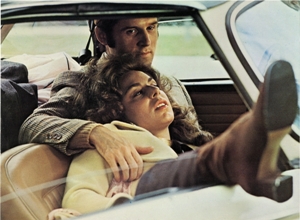
Elaine May’s Hollywood directing career may have been unjustly cut short by the failure of 1987’s Ishtar to recoup its outsized budget, but the four narrative features she currently has to her name are all essential. The Heartbreak Kid is May’s only directorial effort to feature a screenplay by somebody else, but the seething, brutally pointed line-readings from which the film derives most of its comic energy are all her own. (Neil Simon is the sole credited writer, although much of the film was purportedly improvised under May’s direction.) Charles Grodin, in his breakout performance, plays Lenny Cantrow, a Jewish newlywed on his honeymoon in Miami Beach with wife Lila (May’s daughter Jeannie Berlin) who sets his sights on Midwestern Gentile coed Kelly (Cybill Shepherd), ignoring the inconveniences of Kelly’s ever-present father (an apoplectic Eddie Albert) and Lenny’s own very recent marriage. Given May’s astonishing gift for comedic timing, it’s no surprise that each of The Heartbreak Kid’s four principals gives an accomplished and hilarious performance (Albert and Berlin were rewarded with Academy Award nominations for theirs), nor that May is triumphantly successful in making a masterpiece unlike anything seen in the American cinema before or since: a sunny, light, anti-romantic comedy that manages to be one of the bleakest films of the 1970s. (CW)
Introduced by Filmmaker Joe Swanberg.
106 min • Palomar Pictures • 35mm from Academy Film Archive, permission Bristol-Myers Squibb
Film Stock: Kodak 2383 (2006) Lab: Technicolor
Short: “Krasner, Norman: Beloved Husband of Irma” (Shevard Goldstein, 1974) – 6 min – 16mm
Tickets on sale now!
Wednesday, January 10 @ 7:30 PM / NEIU
EMPLOYEES’ ENTRANCE
Directed by Roy Del Ruth • 1933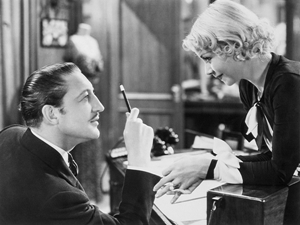
The proprietor of the Franklin Monroe Department Store may be able to trace his lineage back to the Founding Fathers, but the yachted gentry are no match for Kurt Anderson (Warren William), the pitiless manager whose ruthlessly amoral tactics keep the business and its 12,000 employees afloat at the onset of the Great Depression. Once a poor farm boy from Ohio, Anderson rose to the top by adhering to his sole credo: “SMASH! — or be smashed.” Among the wreckage along the way: Loretta Young as the eager model who gets a job by sleeping with the boss, Wallace Ford as the innovative but pliable floor manager, and Alice White as an all-purpose C-suite Mata Hari. Stuffed with a roster of deftly sketched supporting players glimpsed fleetingly in the aisle or the elevator, this boiling backroom epic showcases the protean finesse of undervalued director Roy Del Ruth. Released shortly before Roosevelt’s inauguration, Employees’ Entrance is practically a Hooverism liquidation sale, chucking the dead wood of paralyzed patricians and callous bankers preaching passive retrenchment. The evergreen promise: Americans will go back to work as soon as we hand over the reins to a lecherous authoritarian. (KW)
75 min • First National Pictures • 35mm from Library of Congress, permission Warner Bros.(Swank)
Film Stock: ORWO Lab: Library of Congress
Cartoon: Bugs Bunny in “Hare Conditioned” (Chuck Jones, 1946) – 8 min – 16mm
Wednesday, January 17 @ 7:30 PM / NEIU
WHO’S THAT KNOCKING AT MY DOOR
Directed by Martin Scorsese • 1967
Begun as an NYU student film and eventually released as exploitation fodder after the late addition of an extended sex scene, Martin Scorsese’s first feature Who’s That Knocking at My Door contains all of the director’s stylistic strategies and thematic obsessions in germinal form: Italian-American rough-housing, Catholic guilt, sexual anxiety, and a rock ‘n’ roll soundtrack that unrolls like a muffled jukebox overheard from the bar next door. Court stenographer-turned-actor Harvey Keitel makes his film debut as J. R., an aimless ruffian who spends his days getting drunk with neighborhood buddies at the 8th Ward Pleasure Club. A ride on the Staten Island Ferry changes J. R.’s life when he meets a sophisticated girl (Zina Bethune) reading a French magazine; she impresses him with her college education, while he charms her with his spirited defense of John Ford’s The Searchers. Who’s That Knocking at My Door charts their rocky relationship while interrogating J. R.’s toxic instinct to divide the women of the world into ‘nice girls’ and ‘broads.’ (Even the poster describes Bethune’s nameless character as ‘A Nice Girl But …’) Upon the film’s world premiere at the Chicago International Film Festival, newly appointed Sun-Times critic Roger Ebert declared, “I have no reservations in describing it as a great moment in American movies,” and the rest is history. (KW)
90 min • Trimod Films • 35mm from Chicago Film Society collections, permission Warner Bros. (Swank)
Film Stock: Eastman B+W (1968)
Preceded by: Selected vintage trailers for local film festivals – 16mm – 8 min
Wednesday, January 24 @ 7:30 PM / NEIU
CROOKLYN
Directed by Spike Lee • 1994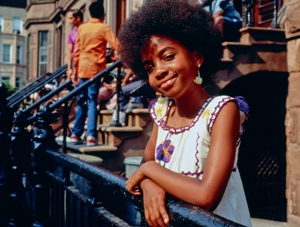
At its core, the semi-autobiographical Crooklyn is director Spike Lee’s love letter to his home borough. Set in the summer of 1973, it wistfully remembers a Brooklyn of hopscotch and baseball cards, of Black and Puerto Rican neighbors living in loud, contentious harmony, a Brooklyn where the local druggies huffed glue instead of smoking crack. It’s a pre-Giuliani paradise where a musician (Delroy Lindo) and a schoolteacher (Alfre Woodard) could afford both a brownstone and a car, the material resources for an almost quaint version of urban domesticity. Co-written with Lee’s siblings Joie and Cinqué, Crooklyn evokes childhood in the city: the film’s emotional center is eldest child and only daughter, 10-year-old Troy, whose perception of the world shapes the movie’s narrative and visual structure. It’s most jarringly highlighted in the visual distortion of scenes at Troy’s relatives’ house in the South, where she briefly stays; the image appears stretched as if projected with the wrong lens, ostensibly to reflect Troy’s feelings of being out of place. Meanwhile the film pulses with a soundtrack straight out of Soul Train, one of Troy’s favorite programs. Family matriarch Carolyn Carmichael may ask in a letter if Troy “isn’t glad to be away from these crazy people in Crooklyn, New York?”, but it’s clear she would never feel at home anywhere else. What New Yorker doesn’t pine for this version of Brooklyn? No wonder the film beat out more canonical choices from the likes of Scorsese to win the recent “One Film, One New York” contest. (JR)
115 min • Universal • 35mm from Universal
Film Stock: Eastman LPP (1994) Lab: Deluxe
Short: “The Balloon Tree” (Ross Lowell, 1970) – 16mm – 10 min
Wednesday, January 31 @ 7:30 PM / NEIU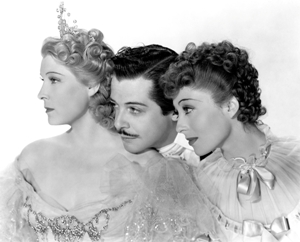
THE GREAT WALTZ
Directed by Julien Duvivier • 1938
Louis B. Mayer’s very favorite M-G-M picture is a highly fictitious account of the early years of beloved Austrian composer Johann Strauss. Fernand Gravet plays our hero, a modest bank clerk who loses his job and begins composing waltzes with a group of scrappy musicians when three-quarter time was the punkest thing ever; Luise Rainer is Strauss’s wife, and the totally radiant real-life coloratura Miliza Korjus (pronounced “Gorgeous,” according to trailer) steals the show as the famous opera singer Clara Donner. A no-expense-spared mega-production complete with 90-piece orchestra, the film’s musical sequences (including one, not even the best one, directed by Josef von Sternberg) are transcendent, and at the time represented the best presentation of Strauss’s music that most of the American public had ever heard. Julien Duvivier, fresh off the success of Pépé le Moko, directed, with cinematography by Joseph Ruttenberg, who won the Academy Award that year. (JA)
104 min • Metro-Goldwyn-Mayer • 35mm from Chicago Film Society collections, permission Warner Bros. (Swank)
Film Stock: Eastman B+W (1962)
Cartoon: “Mr. Strauss Takes a Walk” (George Pal, 1942) – 16mm – 7 min
Wednesday, February 7 @ 7:30 PM / NEIU
FAT CITY
Directed by John Huston • 1972
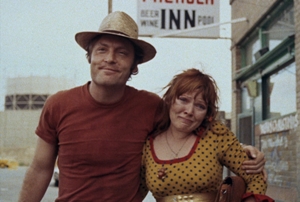 You can expect a film that opens and closes with Kris Kristofferson’s “Help Me Make It Through the Night” to leave some bruises behind after the credits scroll, and Fat City does not disappoint. Two fighters meet and spar in a YMCA, one fresh-faced and climbing, one boozed-up and falling fast. There’s only a 12-year age difference between tenderfoot Ernie Munger (a coltish Jeff Bridges) and the washed-up Billy Tully (played by Stacy Keach), but in this town that’s all that lies between the promise of youth and a lifetime of failure. The fight scenes are pathetic, scrambling affairs and pale in comparison to bouts between lovers Billy and Oma (played by Susan Tyrrell in one of the most viciously accurate portrayals of an onscreen drunk). Shot by the great Conrad Hall (In Cold Blood, Cool Hand Luke) and penned by ex-fighter Leonard Gardner (adapted from his own novel), it’s a deeply loving portrait of the occupants of Stockton, California’s skid row, most of which was bulldozed immediately after the production to make way for a freeway. Fat City’s existential blows are softened by how real it is: a tender hug between fighters after a brutal bout, the casual adjustment of a fallen zipper on a woman’s dress, a confession of love between daytime drunks. As critic Vincent Canby wrote, “This is grim material but Fat City is too full of life to be as truly dire as it sounds.” (RL)
You can expect a film that opens and closes with Kris Kristofferson’s “Help Me Make It Through the Night” to leave some bruises behind after the credits scroll, and Fat City does not disappoint. Two fighters meet and spar in a YMCA, one fresh-faced and climbing, one boozed-up and falling fast. There’s only a 12-year age difference between tenderfoot Ernie Munger (a coltish Jeff Bridges) and the washed-up Billy Tully (played by Stacy Keach), but in this town that’s all that lies between the promise of youth and a lifetime of failure. The fight scenes are pathetic, scrambling affairs and pale in comparison to bouts between lovers Billy and Oma (played by Susan Tyrrell in one of the most viciously accurate portrayals of an onscreen drunk). Shot by the great Conrad Hall (In Cold Blood, Cool Hand Luke) and penned by ex-fighter Leonard Gardner (adapted from his own novel), it’s a deeply loving portrait of the occupants of Stockton, California’s skid row, most of which was bulldozed immediately after the production to make way for a freeway. Fat City’s existential blows are softened by how real it is: a tender hug between fighters after a brutal bout, the casual adjustment of a fallen zipper on a woman’s dress, a confession of love between daytime drunks. As critic Vincent Canby wrote, “This is grim material but Fat City is too full of life to be as truly dire as it sounds.” (RL)
96 min • Columbia • 35mm from Sony Pictures Repertory
Film Stock: Eastman LPP (1985)
Short: “Dick the Bruiser vs. Chest Bernard” (Russ Davis, 1955) – 16mm – 13 min – Courtesy of Chicago Film Archives
Wednesday, February 14 @ 7:30 PM / NEIU
SATAN’S BREW
Directed by Rainer Werner Fassbinder • 1976
In German with English subtitles.
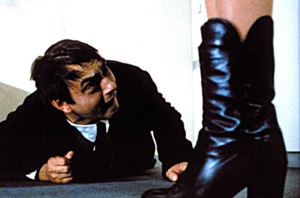 Despite evincing a gift for humor throughout his career, the hyper-prolific and ever-controversial Rainer Werner Fassbinder only once tried his hand at making an out-and-out comedy. That film, Satan’s Brew, just so happened to be one of his most venomous cavalcades of perversion, an anarchic farce trafficking in bad taste and extremely poor manners. Kurt Raab stars as an acclaimed poet desperately avoiding work and looking for new ways to exploit his family and acquaintances in an effort to keep his libido sated and his bank account from being overdrawn. While his beleaguered wife and brother (whose tragic sexual attraction to flies stands among the film’s more baroque touches) live hand-to-mouth in their own filth, Raab’s poet cycles through a series of female benefactors, publicly declares himself the reincarnation of poet Stefan George, and sows a measure of misery extreme even for a Fassbinder film. Be sure to bring along dein Liebling this Valentine’s Day for an evening of insect fondling, fraternal spanking, breakfast expectorating, and other acts of romance. With Volker Spengler, Y Sa Lo, the recently departed Ulli Lommel, and more of your favorite Fassbinder regulars. (CW)
Despite evincing a gift for humor throughout his career, the hyper-prolific and ever-controversial Rainer Werner Fassbinder only once tried his hand at making an out-and-out comedy. That film, Satan’s Brew, just so happened to be one of his most venomous cavalcades of perversion, an anarchic farce trafficking in bad taste and extremely poor manners. Kurt Raab stars as an acclaimed poet desperately avoiding work and looking for new ways to exploit his family and acquaintances in an effort to keep his libido sated and his bank account from being overdrawn. While his beleaguered wife and brother (whose tragic sexual attraction to flies stands among the film’s more baroque touches) live hand-to-mouth in their own filth, Raab’s poet cycles through a series of female benefactors, publicly declares himself the reincarnation of poet Stefan George, and sows a measure of misery extreme even for a Fassbinder film. Be sure to bring along dein Liebling this Valentine’s Day for an evening of insect fondling, fraternal spanking, breakfast expectorating, and other acts of romance. With Volker Spengler, Y Sa Lo, the recently departed Ulli Lommel, and more of your favorite Fassbinder regulars. (CW)
112 min • Albatros Filmproduktion • 35mm from Janus
Film Stock: Unmarked Polyester
Cartoon: “Ein Stachliges Vergnügen” (Heinz Nagel, 1976) – 35mm – 9 min (unsubtitled)
Saturday, February 17 @ 11:30 AM / Music Box Theatre / Live Accompaniment from Music Box Organist Dennis Scott
DRIFTING
Directed by Tod Browning • 1923
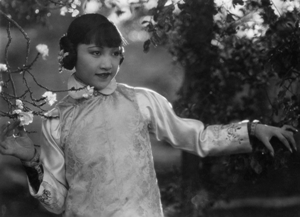 Before he embarked on a series of macabre classics with Lon Chaney for the newly amalgamated M-G-M, Tod Browning was an accomplished director of crime films and melodramas at Universal. Drifting, his last film for that studio, is an old-fashioned barnstormer about the drug trade, loose morals, and the redemptive power of love. Based on a 1910 play by John Colton that had enjoyed a successful Broadway revival in 1922, Drifting toned down its source material considerably at the request of Browning’s regular star Priscilla Dean (Outside the Law), whose “lady of easy virtue” became a run-of-the-mill opium smuggler in China. (Hollywood’s unaccountably vigorous effort to translate the outré provocations of Colton, a gay playwright with a yin for Orientalist absurdity, to the cinema yielded a kind of deranged, censor-sculpted surrealism; when Colton’s The Shanghai Gesture reached the screen in 1941, brothel proprietress Mother Goddamn became the no-less-ridiculous Mother Gin Sling.) Dean’s petty criminal finds herself making common cause with her underworld rival Wallace Beery and strives to throw government agent Matt Moore off their trail. An eighteen-year-old Anna May Wong appears as a local opium supplier’s daughter, who develops a crush on Moore. The unsigned New York Times review probably says it best: “a very improbable story, directed with gusty flights of imagination.” Preservation funded by the National Film Preservation Foundation. (KW)
Before he embarked on a series of macabre classics with Lon Chaney for the newly amalgamated M-G-M, Tod Browning was an accomplished director of crime films and melodramas at Universal. Drifting, his last film for that studio, is an old-fashioned barnstormer about the drug trade, loose morals, and the redemptive power of love. Based on a 1910 play by John Colton that had enjoyed a successful Broadway revival in 1922, Drifting toned down its source material considerably at the request of Browning’s regular star Priscilla Dean (Outside the Law), whose “lady of easy virtue” became a run-of-the-mill opium smuggler in China. (Hollywood’s unaccountably vigorous effort to translate the outré provocations of Colton, a gay playwright with a yin for Orientalist absurdity, to the cinema yielded a kind of deranged, censor-sculpted surrealism; when Colton’s The Shanghai Gesture reached the screen in 1941, brothel proprietress Mother Goddamn became the no-less-ridiculous Mother Gin Sling.) Dean’s petty criminal finds herself making common cause with her underworld rival Wallace Beery and strives to throw government agent Matt Moore off their trail. An eighteen-year-old Anna May Wong appears as a local opium supplier’s daughter, who develops a crush on Moore. The unsigned New York Times review probably says it best: “a very improbable story, directed with gusty flights of imagination.” Preservation funded by the National Film Preservation Foundation. (KW)
82 min • Universal • 35mm from George Eastman Museum
Film Stock: Kodak 2383 (2013)
Short: “The Great Wall of China” (CineArts Production, 1930) – 16mm – 7 min
Monday, February 19 @ 7:00 PM / Music Box Theatre
TWO WEEKS IN ANOTHER TOWN
Directed by Vincente Minnelli • 1962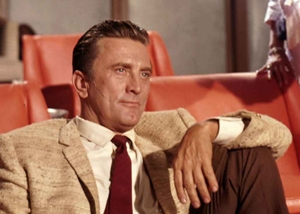
Adapted from a free-standing novel by Irvin Shaw but effectively retrofitted by director Vincente Minnelli, screenwriter Charles Schnee, producer John Houseman, star Kirk Douglas, and composer David Raksin as a spiritual sequel to their own Oscar-winning Tinsel Town satire The Bad and the Beautiful, Two Weeks in Another Town is a mad melodrama that charts Hollywood’s decline while frolicking in the detritus. Douglas stars as Jack Andrus, the Serious Actor discharged from a high-end sanitarium after a cablegram calls him to Rome for two weeks of work at Cinecitta under the direction of longtime collaborator Maurice Kruger (Edward G. Robinson). Upon his arrival, Andrus finds sun-dappled seaside rot: a runaway production that Kruger cannot control, dub-happy actors speaking past each other in different languages on the set, crass financiers who don’t give a damn about showmanship. Like a Henry James story turned inside out, this Metrocolor debauchery circus plays American neuroses against European cynicism and everybody comes up plastered. Shot immediately after Minnelli’s own deeply demoralizing experience on the international co-production The Four Horsemen of the Apocalypse, Two Weeks in Another Town plays like a documentary that really wants to be a psychodrama instead, a craggly self-portrait rounded up to Greek tragedy. With supporting turns from Cyd Charisse, Claire Trevor, and George Hamilton. (KW)
107 min • Metro-Goldwyn-Mayer • 35mm from Warner Bros.
Film Stock: Eastman LPP (1986)
Short: Production Featurette for The Cardinal (Otto Preminger, 1963) – 35mm Technicolor – 8 min
Friday, February 23 @ 7:00 PM / Film Studies Center
LUMINOUS PROCURESS
Directed by Steven Arnold • 1971
Co-presented by the Film Studies Center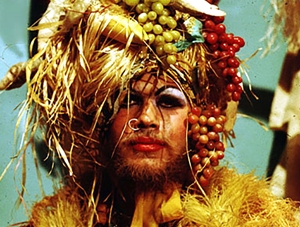
The only feature film of photographer, designer, and Salvador Dalí protégé Steven Arnold, Luminous Procuress is that rarest of endeavors—a lavishly appointed queer underground epic that was tipped as a potential cross-over hit by investors besotted with the softcore success of I Am Curious,Yellow. The cosmic aspirations of this wide-eyed hippie bacchanal are in no way diminished by the fact that it was shot in an abandoned industrial laundry works in San Francisco’s Mission District. As two shaggy-haired simpletons are initiated by the mysterious Procuress, we are guided through a series of sparkling, Kodachrome tableaux of frank couplings, backed by Warner Jepson’s soupy synth score. The Cockettes, the renowned drag troupe that got its start at Arnold’s midnight movie séances, are on hand to provide color commentary. Luminous Procuress premiered at the San Francisco Film Festival, played Director’s Fortnight at Cannes, and received a run at the Whitney before vanishing almost entirely from the avant-garde canon. Newly preserved by BAM/PFA in partnership with the Walker Art Center, Luminous Procuress returns to us, per J. Hoberman, as a “blend of art nouveau stylization, occult rituals, Hollywood camp, and rampant orientalism.” (KW)
75 min • Paramour Pictures • 16mm from Berkeley Art Museum/Pacific Film Archive
Wednesday, March 7 @ 7:30 PM / NEIU
WAY OF A GAUCHO
Directed by Jacques Tourneur • 1952
Just in case you missed our recent screenings of Canyon Passage and Anne of the Indies we’re giving you a third opportunity (offer valid while supplies last!) to experience the sheer and unfettered joy that is a Technicolor Jacques Tourneur film. Rory Calhoun (How to Marry a Millionaire, The Texan) plays a fiery young gaucho who is forced into military service after killing a man in a duel. He quickly deserts and finds himself leading a group of radicalized locals in the fight against the building of a railroad across their land, but a love affair soon complicates his plans for rebellion. Richard Boone (as the militia major hot on Calhoun’s tail) and Gene Tierney co-star in this Argentine Western adapted from a novel by screenwriter Philip Dunne (How Green Was My Valley, The Agony and the Ecstasy), but the real allure of the film lies in its eye-popping location. With the exception of a few scenes, it was shot almost entirely in the Andes Mountains and on the Argentine pampas; think Gene Tierney lounging supine in the lowland grasses and former real-life cowboy Rory Calhoun maneuvering his horse ably in front of snow-capped peaks and endless sky. (RL)
93 min • 20th Century-Fox • 35mm from Fox Library Services
Film Stock: Kodak 2383 (2005) Lab: Triage
Short: “The Face Behind the Mask” (Jacques Tourneur, 1938) – 16mm – 11 min
Saturday, March 10 @ Noon / Music Box Theatre / Live Accompaniment from Music Box Organist Dennis Scott
LITTLE ORPHANT ANNIE
Directed by Colin Campbell • 1918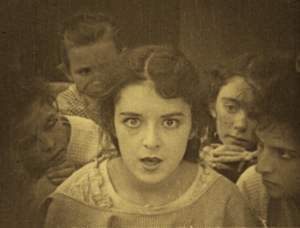
One of the final features produced by Chicago’s own Selig Polyscope before the company’s bankruptcy, Little Orphant Annie is a film steeped in deprivation: children fight over dinners rescued from garbage cans by day, and cower under the covers, menaced by grotesque puppet monsters, by night. Into the breach steps Little Orphant Annie (Colleen Moore, in her earliest extant performance), an eternal optimist and skilled storyteller whose fireside parables teach the other ragamuffins that “the Gobble-uns’ll git you Ef you Don’t Watch Out!” Adapted from the 1885 poem by Indiana’s favorite son James Whitcomb Riley that would later inspire the Little Orphan Annie comic strip, the film version is a work of dark whimsy to stand beside other silent fairy tale productions such as The Blue Bird and Peter Pan, albeit with a higher proportion of cardboard and tarpaulin to outright wonder. (Riley himself, two years deceased at the time of the film’s release, appears as a stock footage apparition at the beginning and the end.) Long available only in tattered and incomplete 16mm prints derived from a 1926 reissue that omitted all production credits, Little Orphant Annie has been painstakingly reconstructed by independent archivist Eric Grayson using materials from the Library of Congress and assorted film collectors. (KW)
Introduced by Eric Grayson.
58 min • Selig Polyscope Company • 35mm from Eric Grayson
Film Stock: Kodak 2383 (2017)
Short: “The Haunted Hotel” (J. Stuart Blackton, 1907) – 16mm – 5 min
Monday, March 26 @ 7:00 PM / Music Box Theatre
LUST IN THE DUST
Directed by Paul Bartel • 1985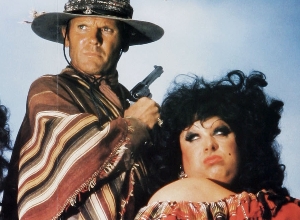
One of the most overlooked talents to come out Roger Corman’s AIP director mill, Paul Bartel never demonstrated the interest in pursuing Hollywood filmmaking that so many of his cine-brat compatriots did, continuing to make the sort of unfashionable, high-concept, and decidedly independent B-pictures his peers had long since abandoned well into the ’90s. Bartel’s Western-comedy Lust in the Dust may have been advertised as something akin to a queer Blazing Saddles, but in its ambling, affable way, it is far more faithful to the genre’s B-movie roots than most of the Westerns produced during the revisionist heyday. Reuniting gay icons Tab Hunter and Divine, previously seen together in John Waters’s Polyester, Lust in the Dust is ostensibly concerned with a love triangle between Hunter’s gunslinger Abel Wood, Divine’s chorus girl-cum-prostitute Rosie Velez, and saloon-owner Marguerita (played by Barbra Streisand’s understudy Lainie Kazan, who, in her musical number “South of My Border,” steals the whole damn movie). There’s some nonsense about a search for gold, but Bartel is most excited just to play in his genre sandbox, trying on tropes (the New Mexico-shot vistas are a particular highlight) and casting off any useless seriousness. (CW)
84 min • New World Pictures • 35mm from Allan Glasser
Film Stock: AGFA
Short: “The Secret Cinema” (Paul Bartel, 1966) – 16mm – 30 min
“The Secret Cinema” has been newly restored by the Academy Film Archive and The Film Foundation with funding provided by The George Lucas Family Foundation.
Tickets on sale here.
Tuesday, April 10 @ 7:30 PM / NEIU
THE MAN FROM PLANET X
Directed by Edgar G. Ulmer • 1951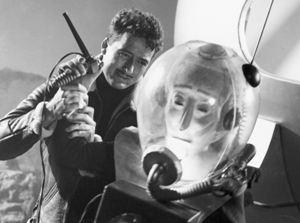
As a mysterious “Planet X” hurtles towards Earth, mustachioed journalist John Lawrence (sci-fi staple Robert Clarke) is invited by a professor friend to the spot where it will come nearest to our planet — deep in the Scottish moors, where the fog machines are working overtime. He’s joined there by a classic woman in distress, a shifty evil doctor, and soon enough, the titular Man from Planet X! The characters are familiar and armed with eye-rolling lines (“We’ll communicate with him geometrically!”) but director Edgar G. Ulmer creates a place of ghostly beauty with the low-budget artful stylization he became famous for in his noirs and B-movies (see Detour or Bluebeard). Filmed on the leftover sets from Victor Fleming’s Joan of Arc, The Man from Planet X feels more like a baroque fairy tale than a sci-fi film, and Ulmer’s ability to get an audience to empathize (seemingly without effort) with a creature who “speaks” with a sorrowful droning noise and has the face of a death mask is nothing less than masterful. He adds a level of depth and complexity to what might have otherwise been another forgettable genre cheapie. As Ulmer himself said, “I was trying to create art and decency, with a style.” (RL)
71 min • Mid-Century Film Productions • 35mm from Park Circus
Film Stock: Eastman B+W (1994)
Cartoon: “Hare-Way to the Stars” (Chuck Jones, 1958) – 35mm – 7 min
Wednesday, April 18 @ 7:30 PM / NEIU
YOLANDA AND THE THIEF
Directed by Vincente Minnelli • 1945
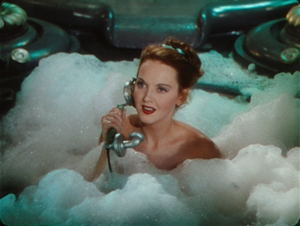 In the immediate wake of Meet Me in St. Louis, director and master stylist Vincente Minnelli found himself an in-demand property at his home studio M-G-M. In the midst of re-envisioning the Judy Garland romance The Clock and contributing sequences to Ziegfeld Follies, Minnelli directed one of the weirdest films to ever be made by a Hollywood studio. Yolanda and the Thief began life as a musical adaptation of a children’s story by Madeline author Ludwig Bemelmans (whose art, along with the paintings of Salvador Dali, serves as one of the film’s chief visual inspirations), but Minnelli saw the film as a chance to direct a full-on “surrealist revue,” a project he had been dreaming of since his early days as a Broadway set designer. Fred Astaire stars as an American gangster running from the law in the fictional and vaguely Latin American country of Patria who sees an opportunity for a quick payday when he encounters the beautiful and grotesquely naive mineral water-heiress Yolanda (Lucille Bremer) and whips up a plan to convince her he is a literal angel sent from Heaven. Minnelli’s marked disregard for coherent plotting or naturalistic performance may have ensured the film would be misunderstood by critics and audiences expecting a traditional Astaire movie, but the director’s refashioning of the Hollywood prestige-musical toolkit in service of bold, avant-garde filmmaking—on full display in the film’s 15-minute dream ballet centerpiece—feels utterly galvanizing today. (CW)
In the immediate wake of Meet Me in St. Louis, director and master stylist Vincente Minnelli found himself an in-demand property at his home studio M-G-M. In the midst of re-envisioning the Judy Garland romance The Clock and contributing sequences to Ziegfeld Follies, Minnelli directed one of the weirdest films to ever be made by a Hollywood studio. Yolanda and the Thief began life as a musical adaptation of a children’s story by Madeline author Ludwig Bemelmans (whose art, along with the paintings of Salvador Dali, serves as one of the film’s chief visual inspirations), but Minnelli saw the film as a chance to direct a full-on “surrealist revue,” a project he had been dreaming of since his early days as a Broadway set designer. Fred Astaire stars as an American gangster running from the law in the fictional and vaguely Latin American country of Patria who sees an opportunity for a quick payday when he encounters the beautiful and grotesquely naive mineral water-heiress Yolanda (Lucille Bremer) and whips up a plan to convince her he is a literal angel sent from Heaven. Minnelli’s marked disregard for coherent plotting or naturalistic performance may have ensured the film would be misunderstood by critics and audiences expecting a traditional Astaire movie, but the director’s refashioning of the Hollywood prestige-musical toolkit in service of bold, avant-garde filmmaking—on full display in the film’s 15-minute dream ballet centerpiece—feels utterly galvanizing today. (CW)
108 min • Metro-Goldwyn-Mayer • 35mm from Warner Bros., Permission Swank
Film Stock: Eastman LPP (1994)
Short: Selected Cartoon
Saturday, April 21 @ 11:30 AM / Music Box Theatre / Live Accompaniment from Music Box Organist Dennis Scott
***Note: Rescheduled from April 7***
A MILLION BID
Directed by Michael Curtiz • 1927
S hortly after Warner Bros. acquired the assets of the ailing Vitagraph Company of America in 1925, the studio embarked on a remake of the latter’s 1914 melodrama A Million Bid. From the start Warner recognized the material’s aptness for contract starlet Dolores Costello (dubbed “The Belle of the Box Office” by the studio), but cycled through several directors—including Alan Crosland and Roy Del Ruth—before ultimately giving the assignment to Hungarian émigré Michael Curtiz, who needed a low-key follow-up to his ostentatious and much-publicized American debut The Third Degree. The plot is high seas hokum: Costello loves a young surgeon (Malcolm McGregor) but is betrothed to a wealthy jerk (Warner Oland) who ponied up a million bucks for the privilege. Oland eventually forces himself upon Costello aboard his yacht (where else?), but a violent storm interrupts his plunder, causing the rapacious millionaire to develop amnesia in the aftermath. The 1914 version of A Million Bid is presumed lost, and for decades it was assumed that the 1927 remake suffered the same fate. A tinted nitrate print with Italian titles was discovered at Cineteca del Comune di Bologna, and became the basis for this restoration from the Library of Congress and L’immagine Ritrovata in 2004. (KW)
hortly after Warner Bros. acquired the assets of the ailing Vitagraph Company of America in 1925, the studio embarked on a remake of the latter’s 1914 melodrama A Million Bid. From the start Warner recognized the material’s aptness for contract starlet Dolores Costello (dubbed “The Belle of the Box Office” by the studio), but cycled through several directors—including Alan Crosland and Roy Del Ruth—before ultimately giving the assignment to Hungarian émigré Michael Curtiz, who needed a low-key follow-up to his ostentatious and much-publicized American debut The Third Degree. The plot is high seas hokum: Costello loves a young surgeon (Malcolm McGregor) but is betrothed to a wealthy jerk (Warner Oland) who ponied up a million bucks for the privilege. Oland eventually forces himself upon Costello aboard his yacht (where else?), but a violent storm interrupts his plunder, causing the rapacious millionaire to develop amnesia in the aftermath. The 1914 version of A Million Bid is presumed lost, and for decades it was assumed that the 1927 remake suffered the same fate. A tinted nitrate print with Italian titles was discovered at Cineteca del Comune di Bologna, and became the basis for this restoration from the Library of Congress and L’immagine Ritrovata in 2004. (KW)
65 min • Warner Bros. • 35mm from Library of Congress
Film Stock: Kodak 2383 (2004)
Short: “His Marriage Wow” (Harry Edwards, 1925) – 20 min – 16mm
Monday, April 30 @7:00 PM / Music Box Theatre
A SCENE AT THE SEA
Directed by Takeshi Kitano • 1991
In Japanese with English subtitles
Best known in the US for violent thrillers like Boiling Point and Sonatine—and better known in Japan as a famous stand-up comedian and TV host—Takeshi Kitano launched his own production company with this gentle, haunting masterpiece. A Scene at the Sea tells the story of a deaf trash collector (Claude Maki) who finds a broken surfboard on his garbage route. He repairs it and, encouraged by his girlfriend (one-time actor Hiroko Ôshima), begins surfing every day, eventually entering in competitions. Driven by the music of frequent Miyazaki collaborator Joe Hisaishi, A Scene at the Sea is a film “with a minimalist eloquence that allows the movie to suggest all the joys and difficulties of life” (Lisa Alspector, Chicago Reader). Named one of the ten best films of the ’90s by David Bordwell, A Scene at the Sea screened for a weeklong run at Facets Cinematheque in 1996 (one of very few US engagements) and has been burned in the brain of this CFS contributor ever since. We guarantee it will stay with you for twenty years or your money back. (JA)
101 min • Office Kitano • 35mm from The Japan Foundation, Permission Tamasa
Film Stock: Kodak 2383 (2002)
Short: “Study in Wet” (Homer Groening, 1964) – 16mm – 9 min
Special Thanks: Shayne Pepper, Michael Hines, Richard Helldobler, Kyle Burke, Cyndi Moran, Robert Ritsema, Ernie Kimlin, Chris Rodriguez, Tom Scanlon, and Erin Dennis of Northeastern Illinois University; Randy Andrews of Swank Motion Pictures; Brian Andreotti & Ryan Oestreich of the Music Box Theatre; David Antos & Chris Omiotek; Brian Belovarac & Ben Crossley-Marra of Janus Films; Daniel Bish, Anthony L’Abbate, & Nancy Kauffman of George Eastman Museum; Cassie Blake, May Haduong, & Charles Rogers of the Academy Film Archive; James Bond of Full Aperture Systems; Rob Byrne & Lucy Laird of the San Francisco Silent Film Festival; Dennis Chong, Jesse Chow, & Eric Chin of Universal; Chris Chouinard of Park Circus; Neil Cooper; Barbara Crandall of Fox Library Services; Steve Darnall; Justin Dean; Justin Dennis of Kinora; Amanda El-Khoury & Chaclyn Hunt; Bill Francik; Julia Gibbs & Benjamin Ruder of the Film Studies Center; Allan Glasser; Eric Grayson; Katherine Greenleaf; Cary Haber of Criterion Pictures, USA; David Jennings of Sony Pictures Repertory; James Layton of the Museum of Modern Art; Steven Lloyd; Steven Lucy; Bob Morrissey; Nicole Woods & Kristie Nakamura of Warner Bros. Classics; Mike Quintero; Dennis Scott; Neal Sabin; Lynanne Schweighofer, Rob Stone, & Mike Mashon of the Library of Congress; Jon Shibata, Mona Nagai, & Steve Seid of Pacific Film Archive; Philippe Spurrell; Tommy Jose Stathes; Joe Swanberg; Sanae Tani of the Japan Foundation; Kiyan Warner; Nancy Watrous, Brian Belak, and Michelle Puetz of Chicago Film Archives; and Joe Yranski
And extra special thanks to our audience, who make it all possible!
